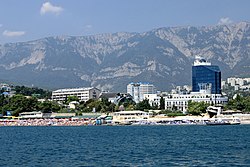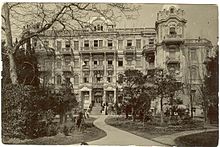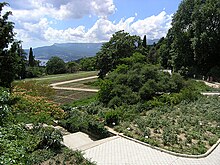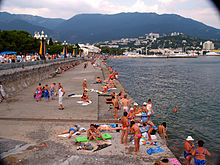Yalta
You can help expand this article with text translated from the corresponding article in Russian. (October 2022) Click [show] for important translation instructions.
|
Yalta
Ялта | |
|---|---|
 | |
|
UTC+3 (MSK) | |
| Postal codes | (2)98600–(2)98639 |
| Area code | +7-3654 |
| Former name | Yalita (until the 15th century) |
| Climate | Cfa |
| Website | yalta |
Yalta
The city is located on the site of the ancient Greek colony of Yalita.[5] It is said to have been founded by the Greek settlers who were looking for a safe shore (Γιαλός, yalos in Greek) on which to land. It is situated on a deep bay facing south towards the Black Sea, surrounded by the mountain range Ai-Petri. It has a humid subtropical climate and is surrounded by numerous vineyards and orchards.[6]
The area became famous when the city held the Yalta Conference as part of the Allied World War II conferences in 1945.
The term "Greater Yalta" is used to designate a part of the Crimean southern coast spanning from
History
12th–19th centuries

The existence of Yalta was recorded in the 12th century by an
In the 19th century, the town became a fashionable resort for the Russian aristocracy and gentry.
20th century

During the 20th century, Yalta was the principal holiday resort of the Soviet Union. In 1920, Vladimir Lenin issued a decree "On the Use of Crimea for the Medical Treatment of the Working People" which endorsed the region's transformation from a fairly exclusive resort area into a recreation facility for tired proletarians. Numerous workers' sanatoria were constructed in and around Yalta and the surrounding district. There were, in fact, few other places that Soviet citizens could come for a seaside holiday, as foreign travel was forbidden to all but a handful. The Soviet elite also came to Yalta; the Soviet premier Joseph Stalin used the Massandra Palace as his summer residence.
Yalta was occupied by the German Army from 9 November 1941 to 16 April 1944.
The town came to worldwide attention in 1945 when the Yalta Conference between the "Big Three" powers – the Soviet Union, the United States and the United Kingdom – was held at the Livadia Palace.
21st century
Following the dissolution of the Soviet Union in 1991, Yalta has struggled economically. Many of the nouveaux riches of ex-Soviet citizens began going to other European holiday resorts, now that they had the freedom and money to travel; conversely, the impoverishment of many ex-Soviet citizens meant that they could no longer afford to go to Yalta. The town's transport links have been significantly reduced with the end of almost all passenger traffic by sea. The longest trolleybus line in Europe goes from the train station in Simferopol to Yalta (almost 90 km). Yalta is crowded in the vacation season (July–August) and prices for accommodation are very high. Most of the tourists are from countries of the former Soviet Union; in 2013, about 12% of tourists to Crimea were Westerners from more than 200 cruise ships.[7]
Yalta has a beautiful seafront
Two beaches in Yalta are Blue Flag beaches since May 2010, these were the first beaches (with two beaches in Yevpatoria) to be awarded a Blue Flag in a CIS member state.[8]
In 2014, Russia, in violation of international law, invaded Crimea and claimed it as part of Russia.[9]
Main sights



Famous attractions within or near Yalta are:
- Yalta's Sea Promenade (Naberezhnaya), housing many attractions, which was renovated in 2003 and 2004.
- Saint Hripsime Church of Yalta, an Armenian Church, with frescoes by V. Surenyants
- A Roman Catholic Church built by Nikolay Krasnov
- Yalta's cable car, taking visitors to the Darsan hill, from which one can see Yalta's shoreline
- Renovated Hotel Taurica, the first hotel in the former Russian Empire with elevators
- Alexander Nevsky Cathedral, constructed by the architect Krasnov, who also constructed the Livadia Palace and the architect P. Terebenyov
- Former main building of the Ministry of Defence hotel, built in the style of a Gothic castle
- Palace of Bukhara Emir
- Yalta's Zoo
- Yalta's Aquarium, housing small dolphins
- Park-museum Polyana Skazok (Glade of Fairytales)
- White Dacha – House-museum of Anton Chekhov
- House-museum of Lesya Ukrainka
- House with Caryatids, where the composer A. Spendiarov lived
- Yalta Hotel Complex
- Roffe Bath, historical monument
Moreover, Yalta's suburbs contain:
- Foros Church
- Nikita)
- Livadiya)
- Organ hall in Livadiya
- Massandra Palace (Massandra)
- Massandra Winery and Vaults
- International children's centre of Artek (Gurzuf)
- Ai-Petri Mountain (1233 metres high, with a cable cartraveling to and from the mountain)
- Alupka Palace
- Swallow's Nest castle near Gaspra.
- Tsar's Path hiking trail
Geography
Climate
As Yalta lies to the south of the
| Climate data for Yalta (1991–2020 normals, extremes 1948–present) | |||||||||||||
|---|---|---|---|---|---|---|---|---|---|---|---|---|---|
| Month | Jan | Feb | Mar | Apr | May | Jun | Jul | Aug | Sep | Oct | Nov | Dec | Year |
| Record high °C (°F) | 17.8 (64.0) |
20.2 (68.4) |
27.8 (82.0) |
28.5 (83.3) |
33.0 (91.4) |
35.0 (95.0) |
39.1 (102.4) |
39.1 (102.4) |
33.2 (91.8) |
31.5 (88.7) |
25.2 (77.4) |
22.0 (71.6) |
39.1 (102.4) |
| Mean daily maximum °C (°F) | 7.4 (45.3) |
7.7 (45.9) |
10.4 (50.7) |
14.8 (58.6) |
20.5 (68.9) |
25.7 (78.3) |
29.1 (84.4) |
29.4 (84.9) |
24.2 (75.6) |
18.3 (64.9) |
12.8 (55.0) |
8.9 (48.0) |
17.4 (63.3) |
| Daily mean °C (°F) | 4.6 (40.3) |
4.6 (40.3) |
6.8 (44.2) |
11.1 (52.0) |
16.4 (61.5) |
21.6 (70.9) |
24.8 (76.6) |
25.0 (77.0) |
20.1 (68.2) |
14.6 (58.3) |
9.7 (49.5) |
6.3 (43.3) |
13.8 (56.8) |
| Mean daily minimum °C (°F) | 2.5 (36.5) |
2.2 (36.0) |
4.1 (39.4) |
8.1 (46.6) |
13.1 (55.6) |
18.1 (64.6) |
21.1 (70.0) |
21.5 (70.7) |
16.8 (62.2) |
11.7 (53.1) |
7.2 (45.0) |
4.1 (39.4) |
10.9 (51.6) |
| Record low °C (°F) | −12.2 (10.0) |
−12.3 (9.9) |
−7.3 (18.9) |
−3.8 (25.2) |
2.8 (37.0) |
7.8 (46.0) |
12.4 (54.3) |
10.0 (50.0) |
3.9 (39.0) |
−1.1 (30.0) |
−8.9 (16.0) |
−7.4 (18.7) |
−12.3 (9.9) |
| Average precipitation mm (inches) | 76 (3.0) |
56 (2.2) |
48 (1.9) |
29 (1.1) |
36 (1.4) |
35 (1.4) |
32 (1.3) |
43 (1.7) |
43 (1.7) |
52 (2.0) |
57 (2.2) |
84 (3.3) |
591 (23.3) |
| Average extreme snow depth cm (inches) | 1 (0.4) |
1 (0.4) |
1 (0.4) |
0 (0) |
0 (0) |
0 (0) |
0 (0) |
0 (0) |
0 (0) |
0 (0) |
0 (0) |
0 (0) |
1 (0.4) |
| Average rainy days | 14 | 12 | 13 | 12 | 11 | 10 | 8 | 7 | 10 | 10 | 12 | 15 | 134 |
| Average snowy days | 6 | 6 | 4 | 0.2 | 0 | 0 | 0 | 0 | 0 | 0 | 1 | 3 | 20 |
| Average relative humidity (%)
|
75.7 | 73.6 | 72.7 | 72.0 | 69.7 | 67.7 | 61.9 | 61.5 | 65.4 | 71.5 | 74.4 | 75.1 | 70.1 |
| Mean monthly sunshine hours | 68.6 | 85.1 | 133.3 | 174.9 | 239.2 | 273.2 | 308.1 | 280.6 | 216.2 | 145.1 | 89.3 | 63.2 | 2,076.8 |
| Source 1: Pogoda.ru.net[10] | |||||||||||||
| Source 2: World Meteorological Organization (humidity and sun 1981–2010)[11] | |||||||||||||


Demographics
As of the
Twin towns – sister cities
Yalta is twinned with:[13][14][15][16]
 Antalya, Turkey
Antalya, Turkey Baden-Baden, Germany
Baden-Baden, Germany Batumi, Georgia
Batumi, Georgia Eilat, Israel
Eilat, Israel Fujisawa, Japan
Fujisawa, Japan Grozny, Russia
Grozny, Russia Kaluga, Russia
Kaluga, Russia Santa Barbara, United States
Santa Barbara, United States Khachmaz, Azerbaijan
Khachmaz, Azerbaijan Latakia, Syria
Latakia, Syria Luhansk, Ukraine
Luhansk, Ukraine Margate, England, United Kingdom
Margate, England, United Kingdom Nice, France
Nice, France Pozzuoli, Italy
Pozzuoli, Italy Rhodes, Greece
Rhodes, Greece Salsomaggiore Terme, Italy
Salsomaggiore Terme, Italy Sanya, China
Sanya, China Sharm El Sheikh, Egypt
Sharm El Sheikh, Egypt Ulan-Ude, Russia
Ulan-Ude, Russia Vladikavkaz, Russia
Vladikavkaz, Russia
Notable people born in Yalta
- Oleksandr Lignau (1872-1938), Ukrainian general and first Minister of War of the Ukrainian State
- Alla Nazimova (1879-1945), Russian-American actress
- Louis Hofbauer (1889-1932), Austrian artist
- Serge Piménoff (1895-1960), French art director
- Alla Horska (1929-1970, Ukrainian artist
- Nika Turbina (1974-2002), Russian poet
- Julia Vakulenko (born 1983), Ukrainian tennis player
- Vera Rebrik (born 1989), Ukrainian-Russian track field athlete
- Valentina Ivakhnenko (born 1993), Ukrainian-Russian tennis player
See also
References
This article needs additional citations for verification. (June 2009) |
- ^ This place is located on the Crimean peninsula, which is internationally recognized as part of Ukraine, but since 2014 under Russian occupation. According to the administrative-territorial division of Ukraine, there are the Ukrainian divisions (the Autonomous Republic of Crimea and the city with special status of Sevastopol) located on the peninsula. Russia claims these as federal subjects of the Russian Federation (the Republic of Crimea and the federal city of Sevastopol).
- ISBN 9781405881180).
- ^ "Fictitious Annexation Follows Voting". 30 September 2022.
- Federal State Statistics Service. Retrieved January 4, 2016.
- ISBN 978-3662518403.
- ^ . Retrieved 28 August 2012.
- ^ New York Times, For Crimea, It's Russian Troops In, Tourists Out, by Neil MacFarquhar, 24 May 2014,
- ^ Four beaches in Crimea receive international certificates of cleanliness, Kyiv Post (May 12, 2010)
- ^ "Crimea: Echoes of history on the road to Yalta". 14 March 2014.
- ^ "Климат Ялты" (in Russian). Погода и климат (Weather and Climate). Archived from the original on 14 December 2019. Retrieved 8 November 2021.
- ^ "World Meteorological Organization Climate Normals for 1981–2010". World Meteorological Organization. Archived from the original on 17 July 2021. Retrieved 18 July 2021.
- ^ Central Statistical Office of AR Crimea Archived 2012-08-28 at the Wayback Machine, see «Ялта», column №3.
- ^ "Ялта и итальянский Родвиго планируют стать городами-побратимами". gazetacrimea.ru (in Russian). Gazeta Crimea. 2017-04-28. Archived from the original on 2021-05-16. Retrieved 2020-04-02.
- ^ "Ялта и Грозный стали городами-побратимами". crimea.kp.ru (in Russian). 2019-08-13. Retrieved 2020-04-02.
- ^ "Ялта и итальянский Родвиго планируют стать городами-побратимами". fontanka.ru (in Russian). Fontanka. 2018-04-22. Retrieved 2020-04-02.
- ^ "Луганск и Ялта побратаются. Луганчан ждут скидки на ЮБК?". cxid.info (in Russian). 2019-01-18. Retrieved 2020-04-02.
External links
 Media related to Yalta at Wikimedia Commons
Media related to Yalta at Wikimedia Commons Yalta travel guide from Wikivoyage
Yalta travel guide from Wikivoyage- . New International Encyclopedia. 1905.
- The murder of the Jews of Yalta during World War II, at Yad Vashem website.
